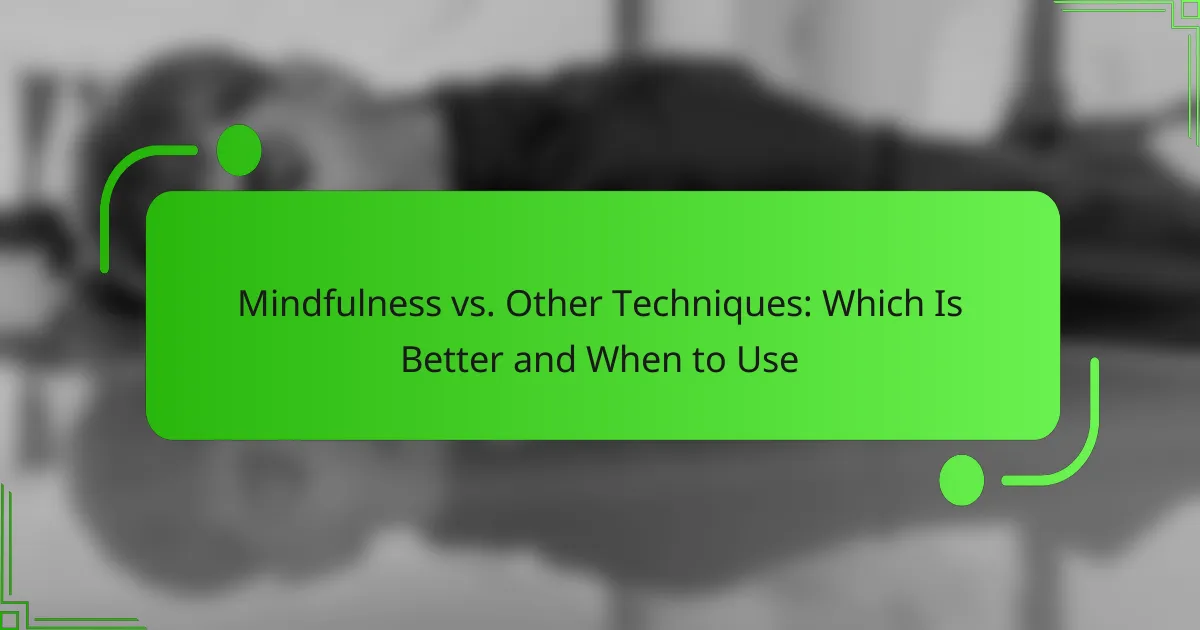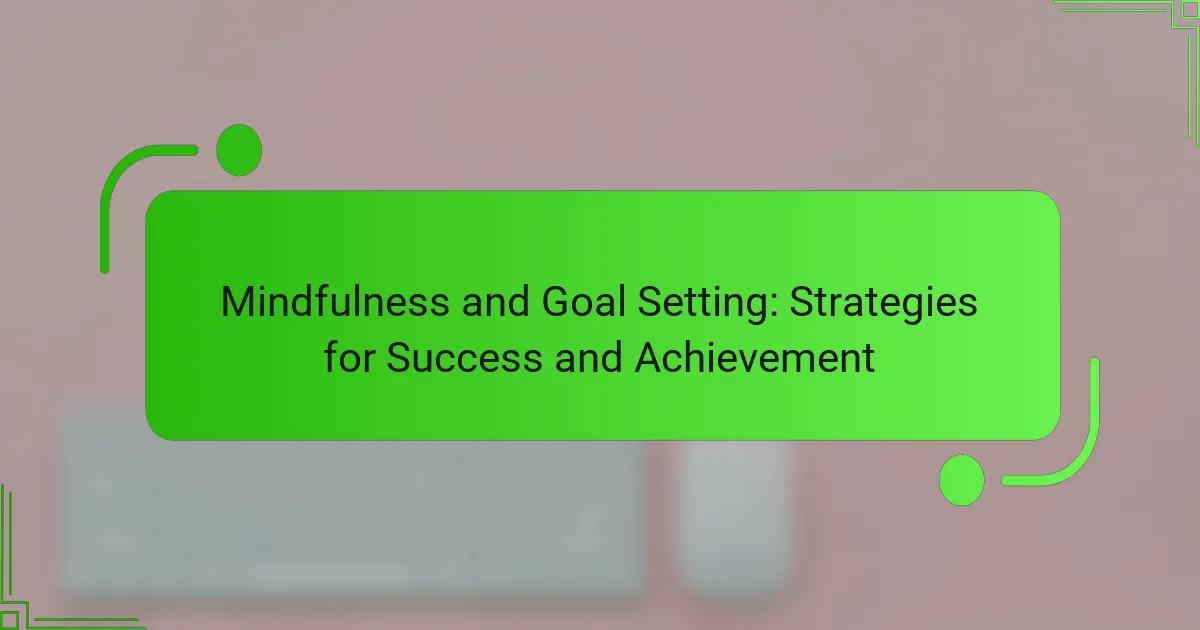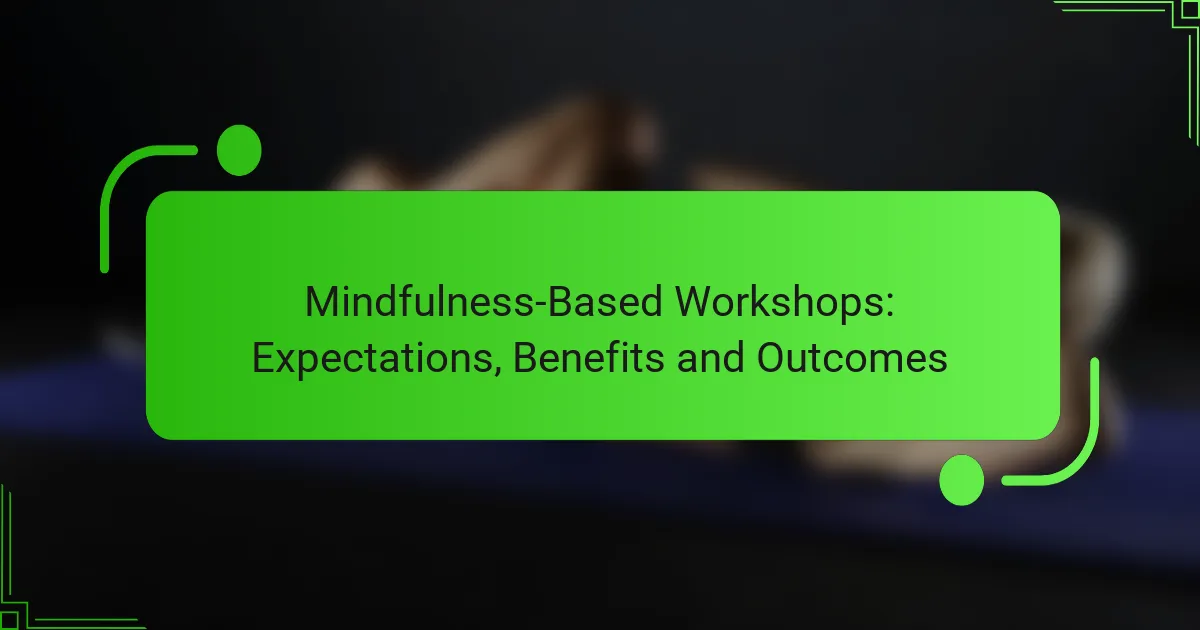Mindfulness is a powerful technique that enhances mental well-being by fostering present-moment awareness, making it particularly effective for stress reduction and emotional regulation. While other methods like cognitive behavioral therapy and relaxation exercises have their own benefits, mindfulness shines in situations requiring immediate focus and grounding, especially during high-stress moments. Understanding when to employ mindfulness versus other techniques can significantly impact personal insights and overall health.
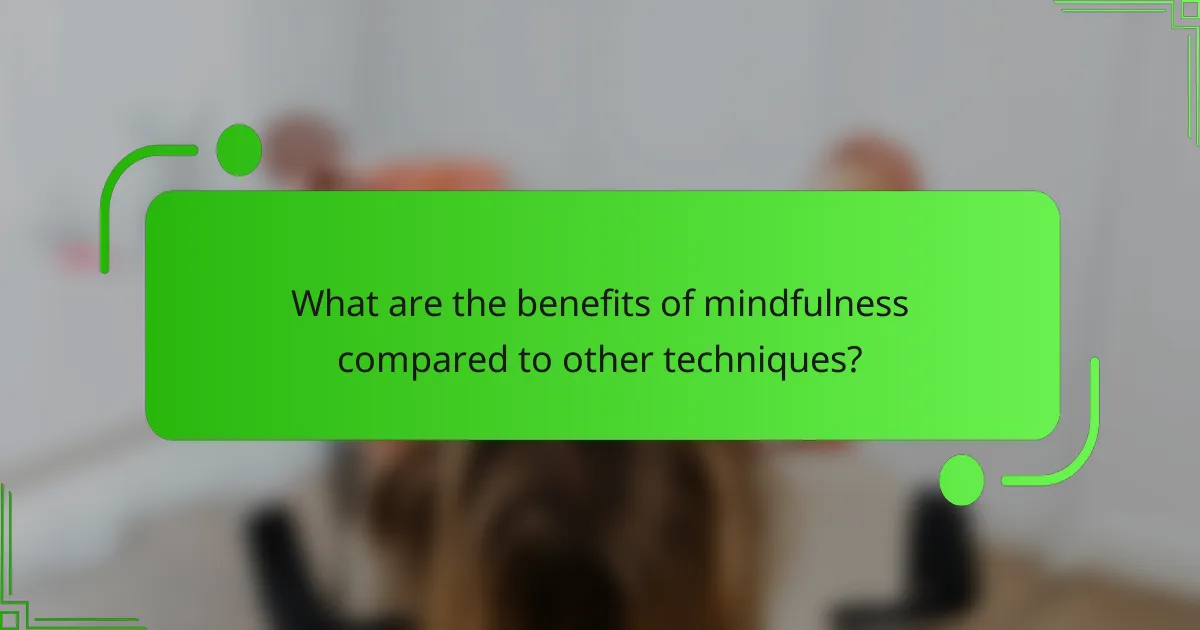
What are the benefits of mindfulness compared to other techniques?
Mindfulness offers unique benefits that can enhance mental well-being, particularly in stress reduction and emotional regulation. While other techniques like cognitive behavioral therapy or relaxation exercises also provide advantages, mindfulness specifically cultivates present-moment awareness, which can lead to profound personal insights and improved overall health.
Stress reduction
Mindfulness is particularly effective for stress reduction as it encourages individuals to focus on the present moment, reducing anxiety about past or future events. Techniques such as mindful breathing or body scans can help lower cortisol levels, promoting relaxation. Practicing mindfulness for just a few minutes daily can significantly alleviate stress over time.
Improved focus
Mindfulness enhances focus by training the mind to concentrate on a single task without distraction. Regular practice can lead to increased attention span and better task performance. For instance, dedicating 10-15 minutes each day to mindfulness meditation can help improve concentration in daily activities.
Enhanced emotional regulation
Mindfulness fosters emotional regulation by helping individuals recognize and acknowledge their feelings without judgment. This awareness allows for better responses to emotional triggers, reducing impulsivity. Techniques like mindful observation can aid in managing emotions more effectively, leading to healthier interpersonal relationships.
Greater self-awareness
Practicing mindfulness cultivates greater self-awareness, enabling individuals to understand their thoughts and behaviors more deeply. This heightened awareness can lead to personal growth and improved decision-making. Engaging in reflective practices such as journaling after mindfulness sessions can further enhance this self-discovery process.
Physical health benefits
Mindfulness is linked to various physical health benefits, including lower blood pressure and improved immune function. Regular practice can lead to healthier lifestyle choices, such as better nutrition and increased physical activity. Incorporating mindfulness into daily routines, such as mindful eating, can contribute to overall well-being and longevity.

When should I use mindfulness over other techniques?
Mindfulness is particularly effective in situations that require immediate focus and emotional regulation. It can be more beneficial than other techniques when you need to ground yourself in the present moment, especially during high-stress events or emotional turmoil.
High-stress situations
In high-stress situations, mindfulness can help you regain composure and clarity. Techniques such as deep breathing or body scans can quickly reduce anxiety and enhance focus. For instance, taking a few minutes to practice mindfulness before a presentation can improve performance and reduce nervousness.
Consider using mindfulness techniques when facing deadlines or conflicts. Engaging in a brief mindfulness exercise can help you respond thoughtfully rather than react impulsively.
Daily routine integration
Integrating mindfulness into your daily routine can enhance overall well-being. Simple practices like mindful eating or walking can transform ordinary activities into moments of awareness. Aim to set aside just a few minutes each day for mindfulness to build a consistent habit.
To incorporate mindfulness, try scheduling short sessions in the morning or during breaks. This can help you stay present throughout the day and manage stress more effectively.
Emotional challenges
Mindfulness is particularly useful during emotional challenges, such as grief or anxiety. It allows you to observe your feelings without judgment, fostering acceptance and understanding. For example, practicing mindfulness can help you navigate feelings of sadness by acknowledging them rather than suppressing them.
When facing emotional turmoil, consider using mindfulness techniques like journaling or guided meditations to process your emotions constructively. These practices can provide clarity and help you develop healthier coping mechanisms.
Long-term mental health maintenance
For long-term mental health maintenance, mindfulness can be a powerful tool. Regular practice has been shown to reduce symptoms of anxiety and depression over time. Aim for at least 10-20 minutes of mindfulness practice several times a week to reap the benefits.
Incorporating mindfulness into your routine can also enhance resilience against stressors. Consider joining a mindfulness group or using apps that provide guided sessions to support your practice and keep you motivated.
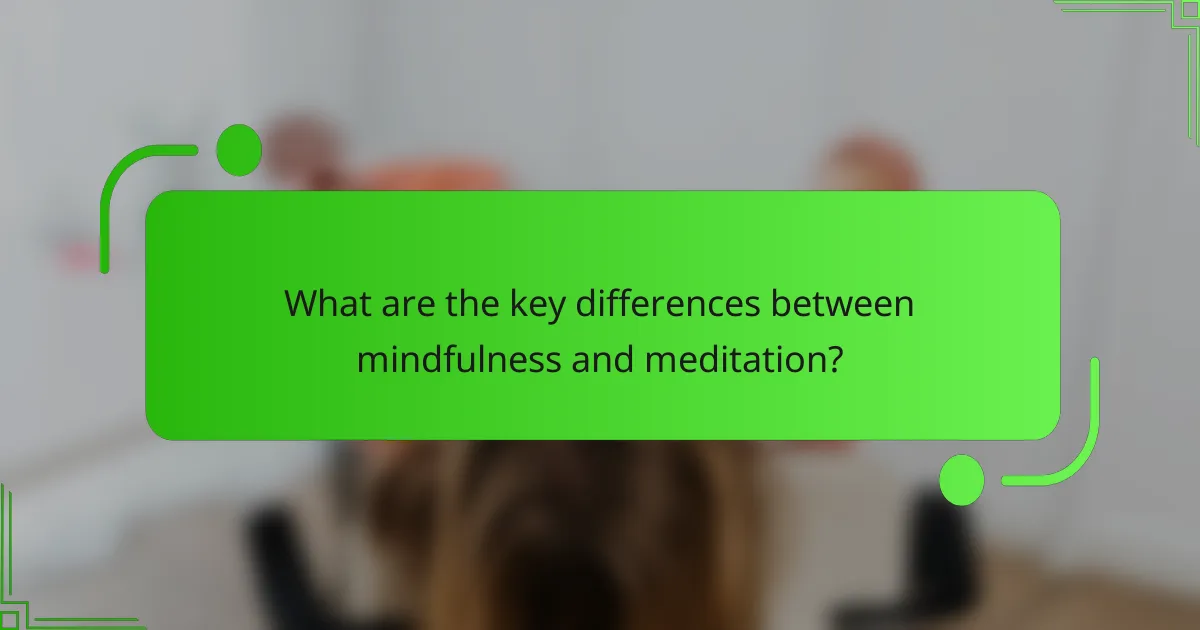
What are the key differences between mindfulness and meditation?
Mindfulness and meditation are related but distinct practices. Mindfulness involves maintaining a moment-to-moment awareness of thoughts, feelings, and surroundings, while meditation typically refers to a structured practice aimed at achieving mental clarity and emotional calm.
Focus on the present
Mindfulness emphasizes being fully present in the moment, encouraging individuals to observe their thoughts and sensations without judgment. This practice can be integrated into daily activities, such as eating or walking, allowing for continuous awareness throughout the day.
In contrast, meditation often involves setting aside specific time to focus on a particular technique, such as breath control or visualization, which may not always prioritize present-moment awareness. This structured approach can lead to deeper states of relaxation and insight.
Technique variety
Mindfulness techniques are generally straightforward and can include practices like mindful breathing, body scans, or mindful eating. These techniques are accessible and can be practiced anywhere, making them easy to incorporate into everyday life.
Meditation, however, encompasses a broader range of methods, including transcendental meditation, guided imagery, and loving-kindness meditation. Each technique serves different purposes and may require specific settings or instructions to be effective.
Duration and practice
Mindfulness can be practiced in short bursts, often lasting just a few minutes, making it suitable for busy lifestyles. Even a few moments of mindful breathing can help reduce stress and enhance focus.
Meditation sessions typically last longer, often ranging from 10 to 30 minutes or more. Regular practice is recommended to experience its full benefits, and individuals may find it helpful to establish a consistent schedule for meditation to cultivate a deeper practice.
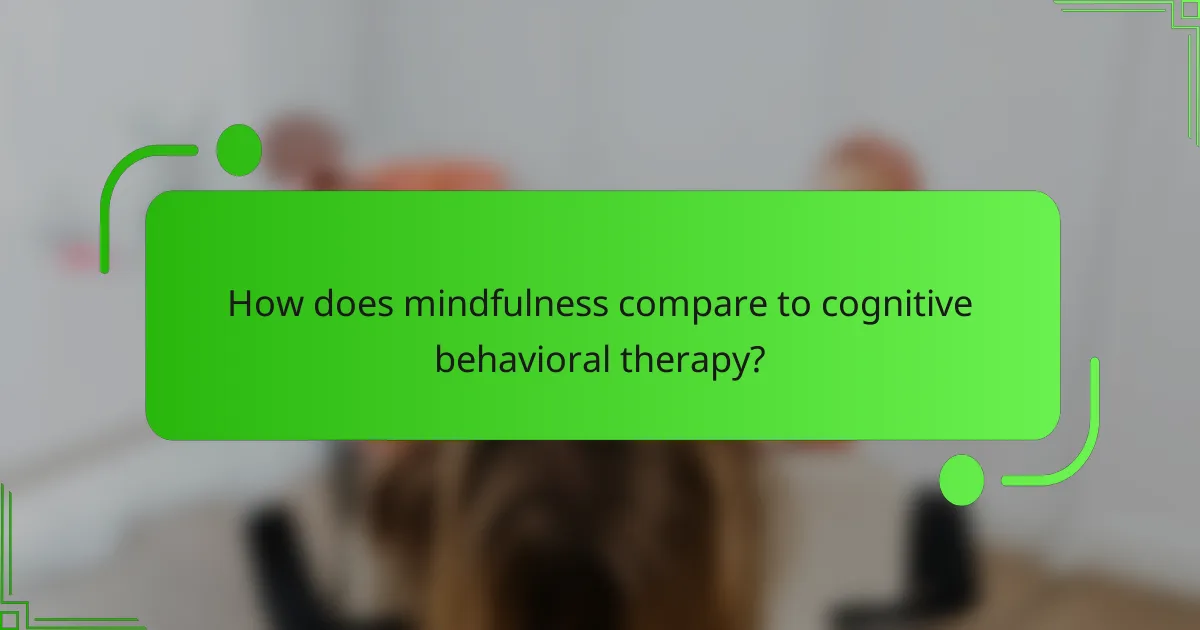
How does mindfulness compare to cognitive behavioral therapy?
Mindfulness and cognitive behavioral therapy (CBT) are both effective techniques for managing mental health, but they differ significantly in their approaches. Mindfulness focuses on present-moment awareness and acceptance, while CBT emphasizes changing negative thought patterns to influence behavior.
Approach to thoughts
Mindfulness encourages individuals to observe their thoughts without judgment, fostering a sense of acceptance. This practice helps reduce the emotional impact of negative thoughts by promoting a non-reactive awareness. In contrast, CBT actively challenges and reframes negative thoughts, aiming to replace them with more constructive ones.
For example, in mindfulness, a person might acknowledge a stressful thought and let it pass without engaging with it, while in CBT, they would identify the thought, evaluate its validity, and work to alter it.
Therapeutic goals
The primary goal of mindfulness is to enhance self-awareness and cultivate a sense of peace and acceptance in the present moment. It aims to reduce stress and improve emotional regulation through consistent practice. Conversely, CBT targets specific psychological issues by aiming to change dysfunctional thinking patterns and behaviors, often with a focus on achieving measurable outcomes.
Individuals seeking to manage anxiety might use mindfulness to develop a calmer mindset, while those looking to address specific phobias might benefit more from the structured approach of CBT.
Session structure
Mindfulness sessions often involve guided meditation, breathing exercises, and reflective practices, typically lasting from 20 to 60 minutes. These sessions may be less structured, allowing for flexibility in practice. In contrast, CBT sessions usually follow a more defined structure, often lasting around 45 to 60 minutes, with specific goals and homework assignments to reinforce learning between sessions.
During a mindfulness session, participants might engage in a body scan or mindful walking, while a CBT session may include discussing recent experiences and identifying cognitive distortions related to those experiences.
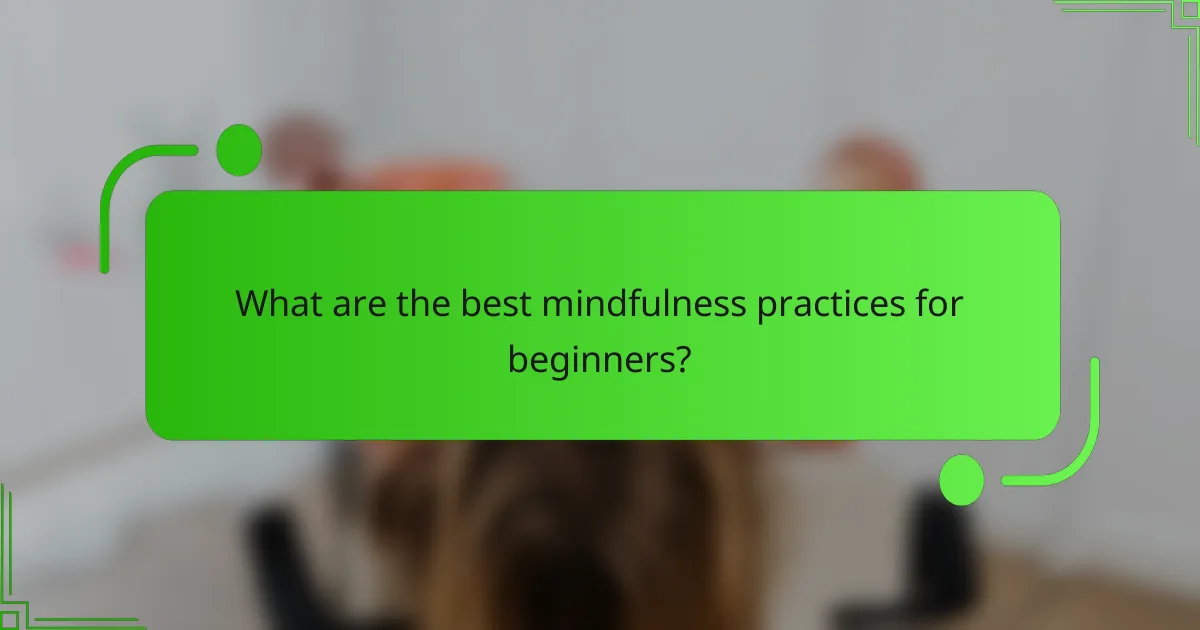
What are the best mindfulness practices for beginners?
For beginners, effective mindfulness practices include guided meditations, breathing exercises, and body scans. These techniques help cultivate awareness and presence, making them accessible and practical for those new to mindfulness.
Guided meditations
Guided meditations involve listening to a narrator or instructor who leads you through the meditation process. This can be particularly helpful for beginners, as it provides structure and direction. Many apps and online platforms offer a variety of guided sessions, ranging from a few minutes to over an hour.
When choosing a guided meditation, consider your goals—whether it’s relaxation, focus, or stress relief. Start with shorter sessions, around 5 to 10 minutes, and gradually increase the duration as you become more comfortable.
Breathing exercises
Breathing exercises are simple yet powerful techniques that focus on the breath to enhance mindfulness. One effective method is the 4-7-8 technique, where you inhale for 4 seconds, hold for 7 seconds, and exhale for 8 seconds. This practice can help calm the mind and reduce anxiety.
To incorporate breathing exercises into your routine, set aside a few minutes each day. Find a quiet space, sit comfortably, and focus solely on your breath. Avoid distractions and aim for consistency to build your practice over time.
Body scans
Body scans involve mentally scanning your body from head to toe, paying attention to sensations, tension, or discomfort. This practice promotes awareness of physical sensations and helps you connect with your body. It can be done lying down or sitting comfortably, making it accessible for most beginners.
To perform a body scan, start at the top of your head and slowly move down to your toes, taking note of how each part feels. Aim for a duration of 10 to 20 minutes, and practice regularly to deepen your mindfulness experience.
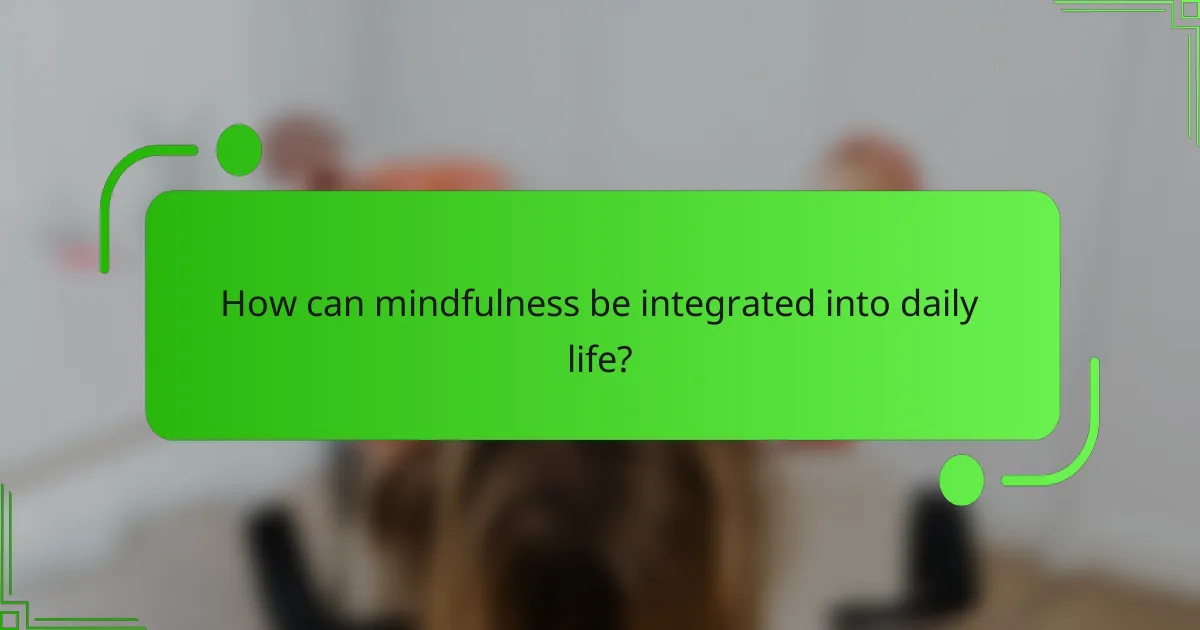
How can mindfulness be integrated into daily life?
Mindfulness can be seamlessly integrated into daily life through simple practices that promote awareness and presence. Incorporating mindfulness into routine activities enhances focus and reduces stress, making it a valuable tool for overall well-being.
Mindful Breathing
Mindful breathing is a foundational practice that involves paying attention to your breath as it flows in and out. You can practice this anywhere, whether sitting at your desk or waiting in line. Aim for a few minutes of focused breathing, inhaling deeply through your nose and exhaling slowly through your mouth.
To enhance this practice, try counting your breaths or visualizing each inhale as a wave of calm. This can help ground you and bring your attention back to the present moment, especially during stressful situations.
Mindful Eating
Mindful eating encourages you to savor each bite and appreciate the flavors, textures, and aromas of your food. This practice can transform meals into a more enjoyable experience and help prevent overeating. Start by eliminating distractions, such as screens, and focus solely on your meal.
Consider taking smaller bites and chewing slowly, allowing yourself to fully experience the food. This not only enhances enjoyment but also aids digestion and promotes healthier eating habits.
Mindful Walking
Mindful walking involves being present while you walk, paying attention to the sensations in your body and the environment around you. You can practice this during your daily commute or while taking a break. Focus on the feeling of your feet touching the ground and the rhythm of your breath.
To deepen this practice, try walking in nature, where you can also engage your senses by noticing the sights, sounds, and smells around you. This can significantly boost your mood and help clear your mind.
Mindfulness in Conversations
Integrating mindfulness into conversations means actively listening and being fully present with the person you are speaking with. This practice fosters deeper connections and enhances communication. Focus on what the other person is saying without planning your response while they talk.
To practice this, maintain eye contact and observe non-verbal cues. This not only shows respect but also helps you understand their perspective better, leading to more meaningful interactions.
